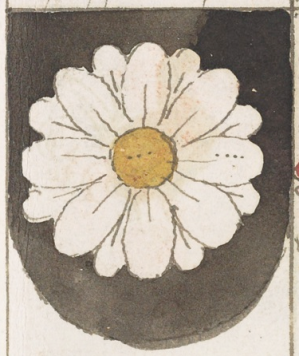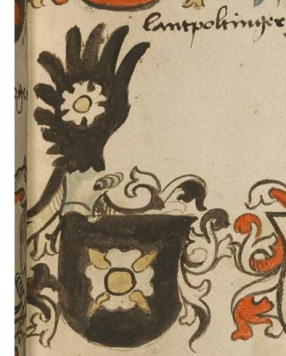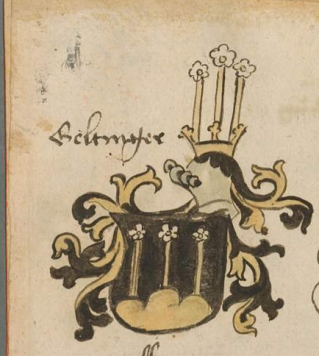Flowers (Charge)
WARNING: Do not cite this page as a reference. This page is on this wiki only to make the content "searchable" and easier to find. If you find the information you seek here, go to the original sources to verify the information and use them for your documentation.
Examples:[edit | edit source]
Period:[edit | edit source]

|
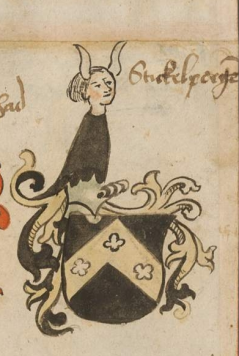
|
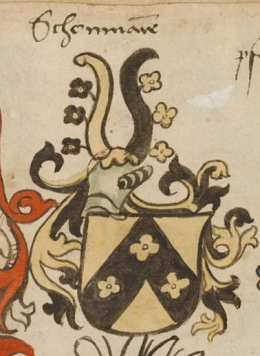
|
| Familienwappen des Hohen Adels, 40v, gore with flowers | Familienwappen des Hohen Adels, 27r, argent flowers on an Or chevron | Familienwappen des Hohen Adels, 27v, Or flowers on sable chevron |
| Image |
| Image created by Christie Ward (Gunnvor silfraharr). Used with permission. |
| Image #1 has the earliest known depictions of tulips on tiles excavated from the thirteenth-century palace that one of the Seljuk sultans, Alaeddin Kaikubad I, built on Lake Beysehir in eastern Anatolia. (Photos http://www.pbase.com/dosseman) |
Image #2 is from the Museum of Turkish and Islamic Arts in Istanbul and shows the back of a simple cotton shirt made to be worn beneath armor and richly decorated with verses from the Koran on the front and embroidered tulips on the back. This shirt was taken from the tomb of one of the Ottoman generals who fought at Kosovo at the Field of Blackbirds, 1389. (http://www.museumwnf.org/islamicart/database_item.php?id=object%3BISL%3Btr%3BMus01%3B18%3Ben]])
Image #3 is a caftan with tulip motifs belonging to Sultan Murad III 1574-1595 (http://www.defineyeri.net/tarihi-takilar-ve-resimleri/sultan-iii-murad%27in-kaftani-1574-1595-topkap isarayi/).
Image #4 "Tulip in the Garden of Johann Heinrich Herwart" by Swiss botanist Conrad Gesner, April 1559. Gesner thought it looked looked like a red lily, and he called it Tulipa turcarum. (http://penelope.uchicago.edu/~grout/encyclopaedia_romana/aconite/gesner.html)
Image #5 Conrad Gesner's wood block print of a tulip in his De Hortis Germaniae Liber Recens, 1561. (http://penelope.uchicago.edu/~grout/encyclopaedia_romana/aconite/gesner.html)
Research courtesy of Christie Ward (Gunnvor silfraharr).
Modern:[edit | edit source]
Pictorial Dictionary of SCA Heraldry (3rd edition):[edit | edit source]
- Flower, see also: columbine, daisy, edelweiss, foil, Gendy flower], gillyflower, iris, lily, lotus, rose, teazel, thistle, trillium, tulip.
- For related charges, see fleur-de-lys, slip, wreath.
Vector Graphics:[edit | edit source]
Book of Traceable Heraldic Art
Annotated Pennsic Traceable Art Project[edit | edit source]
A Heraldic Primer: Flowers, Trees and Plants[edit | edit source]
http://heraldry.sca.org/primer/flora.html
The animal kingdom is not the only resource which was drawn upon for period armory. There are many forms of plant life which can be used as charges. These include flowers, trees and fruits/nuts. When a flower has a stem attached, it is termed slipped. When it has a stem and leaves attached, it is termed slipped and leaved. When the leaves of a rose have a different tincture than the flower, they are referred to as barbed and when the center of the rose is a different tincture, it is referred to as seeded.
 |
 |
 |

|
| A rose argent, barbed vert | A thistle argent, slipped and | A Fleur-de-lys argent | A trefoil argent |
| and seeded gules | leaved vert |
Note that the trefoil and the Fleur-de-lys are stylised representations of flowers.
Sources:[edit | edit source]
- Academy of St. Gabriel "Medieval Heraldry Archive" - http://www.s-gabriel.org/heraldry/
- Archive of St. Gabriel reports - [[1]]
- Laurel Armory Articles - http://heraldry.sca.org/laurel/armory_articles.html
- New Heraldic Primer (Heraldry for Non-Heralds) - http://heraldry.sca.org/armory/newprimer/
- Pictorial Dictionary of Heraldry (PicDic), 3rd Edition - http://mistholme.com/pictorial-dictionary-of-heraldry
- Period Armorials
- Parker's Heraldry - http://karlwilcox.com/parker/
- Riestap's Armorial Général - http://www.euraldic.com/lasu/bl/bl_a_aa.html
Precedents:[edit | edit source]
Precedents of the SCA College of Arms - http://heraldry.sca.org/laurel/precedents.html
Morsulus Heralds Website - http://www.morsulus.org/ (to search the LoARs and Precedents)
Use the above links to be sure any precedents listed below haven't been superseded by newer precedents.
Definition/Defining Instance:[edit | edit source]
November 2020 - On Oriental[edit | edit source]
For several decades, the use of the term "Oriental" has been increasingly seen as tainted by a history of racism against the people of east Asia, their culture, and their artifacts: I myself encountered this fact as a student in the mid-1990s. And while it is true that every person's experience is their own, it is also true that the problems of racism and bigotry remain, and that a term that once simply meant "Eastern" now encompasses other baggage which we do not intend to carry.
Therefore, effective immediately, we are discontinuing use of the term "Oriental" to disambiguate charge variants. New blazon will be determined and appropriate reblazons will occur as we proceed.
Affected charges to be reblazoned soon include:
- Oriental poppy, which appears to have no other name, but which has a central, contrasting coloration different from the Californian poppy will be called a poppy, the unblazoned differences again left to license. The single instance of this in blazon already notes the difference as seeded sable, which will be retained.
https://heraldry.sca.org/loar/2020/11/20-11cl.html
October 2016 - Where the Wild Foils Grow[edit | edit source]
- Often enough we see submission with flowers of X petals blazoned as X-foils. It is not clear where this originated from, but foils are heraldic depictions of clovers and their leaves have a fairly defined shape (with some minor variations). Using the blazon of an X-foil to describe the emblazon of a flower with X petals, where the petals are typically round and attached to the center at a single point or in such other manner that there's obvious "seeding", does not necessarily ensure the reproducibility of the submitted charge from that blazon. SENA A.1.B states that We register the emblazon, rather than the blazon. Any discrepancies between the image and the description will be resolved by changing the description to match the image. To allow for reproducibility of what the submitter has submitted, we have been and will continue reblazoning X-foils that do not look like actual X-foils as the closest known period flower of X petals, or returning for redraw if no accurate blazon can be found.
- http://heraldry.sca.org/loar/2016/10/16-10cl.html
March 2013 - tiny tertiary charges on petals are artistic detail[edit | edit source]
Elyse Morgaine. Badge. (Fieldless) A rose proper. Blazoned on the Letter of Intent as each petal charged with a lozenge Or, the lozenges here are sufficiently small and match the center seeding tincture, giving the overall impression of just an artistic detail on the rose, not a distinct tertiary charge group. This then is indistinguishable from an uncharged rose.This badge is returned for conflict with the well-known badge of the House of Lancaster, //(Fieldless) A rose gules//.This badge is also returned for conflict with the badge of Dana of Coleraine, //(Fieldless) A primrose gules, slipped and leaved and seeded proper. There is a DC for fieldlessness, but no difference between a rose and a primrose, nor any difference for the slipping and leaving.
July 2007 - sunflower proper with brown or sable seeds, seeds not a tertiary charge[edit | edit source]
"We hereby overturn the November 2000 precedent and allow sunflowers proper to be registered. Just as a thistle proper can have its tuft either gules or purpure, a sunflower proper may have either brown or sable seeds. For purposes of conflict checking, the tincture of a sunflower's seeds is not worth a difference. The presence of these seeds does not count as a tertiary charge. July 2007 LoAR Cover Letter
July 1993 - flower slipped vs branch flowered:[edit | edit source]
In cases [where a slipped and leaved flower consists primarily of the branch portion rather than the flower portion], I will register the plant as a branch with a flower. Moreover, I intend to grant a Substantial Difference (i.e., sufficient to invoke Rule X.2) between a branch (flowered or not) and a flower. Slipped flowers drawn with the flower dominant will still be considered negligibly different from a plain flower. Flowers whose slips are part of the definition (e.g., trefoil, thistle) will not get extra difference for the slip [for full discussion, see under BLAZON (24 July, 1993 Cover Letter (June, 1993 LoAR), pg. 7) [2]
Registerability:[edit | edit source]
(Restricted, Reserved, SFPP, OOP)
July 2007 - sunflowers proper now registerable[edit | edit source]
"We hereby overturn the November 2000 precedent and allow sunflowers proper to be registered. Just as a thistle proper can have its tuft either gules or purpure, a sunflower proper may have either brown or sable seeds. For purposes of conflict checking, the tincture of a sunflower's seeds is not worth a difference. The presence of these seeds does not count as a tertiary charge. July 2007 LoAR Cover Letter
Conflict:[edit | edit source]
March 2020 - From Wreath: Roses and Columbines, etc.[edit | edit source]
Recently, the question came up about how much heraldic difference we grant for type of flower. It arose with the submission of Adriana de Fleurs, Azure, three columbines slipped and leaved argent, pended on the LoAR of October 2019. The issue was potential conflict with the registered arms of Jonas Aquilian, Azure, three roses argent. Our current policy allows a DC to be granted for type of flower, but not the Substantial Change sufficient to clear conflict on its own.
When looking to period heraldry for guidance in a case like this, there are two patterns we like to consider: are there examples of one coat of arms containing two different types of flowers? That would suggest that those flowers were distinguished in period heraldry. And are there examples of the same arms recorded in different rolls as having different types of flowers? That would suggest that those flowers were not distinguished.
We've the added issue that we don't know the period blazons of many arms with flowers, and therefore don't know which flowers were intended. (Modern heraldic authors have the same issue: a lot of flowers are simply blazoned flowers by modern authors.) Nonetheless, we've identified a few cases that help us.
Three examples, from British sources, of arms with two different types of flowers would be the arms of Cooke, c.1520: Sable, on a chevron Or between three roundels argent three cinquefoils sable, on a chief argent three columbines azure slipped and leaved vert; the arms of West, d.1533, Argent, on a chevron sable between roses gules slipped vert a lily Or; and the attributed arms of S. Ethelburga or Eadburga, from Peter Le Neve's Book c.1480, Azure, three columbines pendant argent slipped vert crowned Or, in base three roses 2&1 gules seeded Or, all within a bordure gules platy. These suggest that period heralds made a distinction between roses (cinquefoils), affronty and with few petals, and columbines, trumpet-shaped and in profile.
On the other hand, we have multiple examples of the same coat of arms, in different rolls, with different flowers. We have too many examples of arms variously recorded with roses, cinquefoils, or sexfoils to not consider them as pretty much interchangeable in period British heraldry. Other examples are less commonly found, but pertinent: the arms of West, d.1533, shown with either roses or gillyflowers; the arms of Ruthall or Rowthall, 1523, ditto; the arms of Hornby, c.1520, shown with either gillyflowers or marigolds; and the aforementioned arms of S. Ethelburga, with garden lilies inverted instead of columbines. Most confusing were the arms of Forest, c.1525, with a chevron charged (depending on the source) with a rose between two gillyflowers, a gillyflower (pink) between two marigolds, a rose between two marigolds, or three gillyflowers.
The examples suggest that period heralds might not distinguish between trumpet-shaped flowers in profile; might not distinguish between flowers with few petals, affronty; and might not distinguish between multi-petaled flowers (and that the latter might or might not be shown in profile). Any flower not trumpet shaped might be interpreted as a rose simply because roses were so ubiquitous.
Flowers in other categories were too rarely found to allow us to draw concrete deductions. (Thistles, in particular, were much less frequent in period than in the Society.)
We've reached a point where a comprehensive ruling is needed, such as has been done for type of bird (Cover Letter, Nov 2003) and type of tree (Cover Letter, Dec 2018). We therefore rule as follows:
- There is no difference for type between few-petaled flowers affronty (roses, sexfoils, poppies affronty, cherry blossoms, etc.). This is already our current policy.
- There is no difference for type between trumpet-shaped flowers in profile (columbines, lilies, tulips, daffodils, etc.). There can be a DC for orientation (as between columbines and lilies when both are in their default).
- There is no difference for type between multi-petaled flowers affronty (gillyflowers, chrysanthemums, daisies, etc.). Society practice doesn't normally depict such flowers in profile.
- There is SC for type between few-petaled flowers affronty, multi-petaled flowers affronty, and trumpet-shaped flowers in profile.
Flowers that don't fall into the above categories (the all-encompassing "miscellaneous" category) will be treated as individual cases, by type. We are likely, for instance, to grant SC between thistles and the above categories. Lotus flowers in profile, though not an SC from the trumpet-shaped flowers, might still be granted a DC from them; however, lotus flowers affronty will be treated as multi-petaled flowers affronty.
As for foils, our current policies remain in force. We'll still grant difference between, e.g., a trefoil and a cinquefoil: we've not found instances where those charges were conflated. And we'll still grant no difference between a cinquefoil and a rose: we've plenty of instances for those. If further evidence is brought, we can consider it then.
For now, the germane point is that we now grant an SC between roses and columbines, allowing the registration of Adriana's submission.
July 2007 - no difference for tincture of sunflowers seeds[edit | edit source]
"We hereby overturn the November 2000 precedent and allow sunflowers proper to be registered. Just as a thistle proper can have its tuft either gules or purpure, a sunflower proper may have either brown or sable seeds. For purposes of conflict checking, the tincture of a sunflower's seeds is not worth a difference. The presence of these seeds does not count as a tertiary charge. July 2007 LoAR Cover Letter
July 1993 - flower slipped vs branch flowered:[edit | edit source]
In cases [where a slipped and leaved flower consists primarily of the branch portion rather than the flower portion], I will register the plant as a branch with a flower. Moreover, I intend to grant a Substantial Difference (i.e., sufficient to invoke Rule X.2) between a branch (flowered or not) and a flower. Slipped flowers drawn with the flower dominant will still be considered negligibly different from a plain flower. Flowers whose slips are part of the definition (e.g., trefoil, thistle) will not get extra difference for the slip [for full discussion, see under BLAZON (24 July, 1993 Cover Letter (June, 1993 LoAR), pg. 7) [3]
Identifiability:[edit | edit source]
Collected Precedents:[edit | edit source]
- 2nd Tenure of Elisabeth de Rossignol (April 2011 - August 2011) - Collected Armory Precedents
- 1st Tenure of Elisabeth de Rossignol (May 2005 - July 2008) - FLOWER -- Lily , FLOWER -- Miscellaneous
- The 2nd Tenure of François la Flamme (October 2004 - May 2005) - FLOWER -- Lily, FLOWER -- Miscellaneous, FLOWER -- Trillium
- The Tenure of Shauna of Carrick Point (May 2004 - August 2004) - Collected Armory Precedents
- 1st Tenure of François la Flamme (August 2001 - April 2004) - Collected Armory Precedents
- The Tenure of Elsbeth Anne Roth (June 1999 - July 2001) - Collected Armory Precedents
- The Tenure of Jaelle of Armida (June 1996 - June 1999) - Single HTML Document
- 2nd Tenure of Da'ud ibn Auda (November 1993 - June 1996) -
- The Tenure of Bruce Draconarius of Mistholme (June 1992 - October 1993) - Collected precedents
- 1st Tenure of Da'ud ibn Auda (June 1990 - June 1992) -
- The Tenure of Alisoun MacCoul of Elphane (September 1986 - June 1990) - Collected Precedents
- The Tenure of Baldwin of Erebor (August 1984 - August 1986) - Single HTML Document
- The Tenure of Wilhelm von Schlüssel (August 1979 - August 1984) - Collected Precedents
- The Tenure of Karina of the Far West (December 1975 - June 1979) - Collected Precedents
- The Early Days (June 1971 - June 1975) - Collected Precedents
In the Ordinary[edit | edit source]
(includes blossum, bud)
- Flower - Adonis - see Flower - Rose]
- Flower - Almond - see Flower - Rose]
- Flower - Amaranth - see Flower - Multipetaled]
- Flower - Aster - see Flower - Multipetaled]
- Flower - Basil - see Flower - Multifloreted]
- Flower - Blackeyed susan - see Flower - Multipetaled]
- Flower - Bluebottle - see Flower - Multipetaled]
- Flower - Borage - see Flower - Rose]
- Flower - Bouquet] (includes nosegay)
- Flower - Brooklime - see Flower - Rose]
- Flower - Buttercup - see Flower - Cup shape]
- Flower - Calla lily - see Flower - Trumpet shape]
- Flower - Camellia - see Flower - Multipetaled]
- Flower - Carnation - see Flower - Multipetaled]
- Flower - Chamomile - see Flower - Rose]
- Flower - Cherry - see Flower - Rose]
- Flower - Chicory - see Flower - Multipetaled]
- Flower - Chrysanthemum - see Flower - Multipetaled]
- Flower - Cinquefoil - see Flower - Rose]
- Flower - Clover - see Flower - Rose]
- Flower - Columbine - see Flower - Trumpet shape]
- Flower - Copihue - see Flower - Trumpet shape]
- Flower - Cornflower - see Flower - Rose]
- Flower - Crocus - see Flower - Trumpet shape]
- Flower - Cup shape]
- Flower - Daffodil - see Flower - Trumpet shape]
- Flower - Daisy - see Flower - Multipetaled]
- Flower - Dandelion - see - Multipetaled]
- Flower - Dogwood - see Flower - Rose]
- Flower - Dondril - see - Rose]
- Flower - Dryas - see Flower - Rose]
- Flower - Edelweiss - see Flower - Multipetaled]
- Flower - Eglantine - see Flower - Rose]
- Flower - Few petals - see Flower - Rose]
- Flower - Firewheel - see Flower - Multipetaled]
- Flower - Flax - see Flower - Rose]
- Flower - Foil - see Foil]
- Flower - Forget me not - see Flower - Rose]
- Flower - Foxglove - see Flower - Multifloreted]
- Flower - Fraise - see Flower - Rose]
- Flower - Garden rose - see Flower - Rose]
- Flower - Gardenia - see Flower - Multipetaled]
- Flower - Gendy - see Flower - Rose]vs
Gendy flower - see Flower - Iris]
- Flower - Gentian - see Flower - Cup shape]
- Flower - Gillyflower - see Flower - Multipetaled]
- Flower - Gladiolus - see Flower - Multifloreted]
- Flower - Hawthorn - see Flower - Rose]
- Flower - Heartsease - see Flower - Rose]
- Flower - Heather - see Plant - Heather] and Flower - Multifloreted]
- Flower - Heraldic rose - see Flower - Rose]
- Flower - Hollyhock - see Flower - Rose]
- Flower - Honeysuckle - see Flower - Trumpet shape]
- Flower - Hyacinth - see Flower - Multifloreted] #floweriris
- Flower - Iris]
- Flower - Jasmine - see Flower - Rose]
- Flower - Jonquil - see Flower - Trumpet shape]
- Flower - Kendall - see Flower - Rose]
- Flower - Lilac - see Flower - Multifloreted]
- Flower - Lily - see Flower - Trumpet shape]
- Flower - Lily of the valley - see Flower - Multifloreted]
- Flower - Lotus - see Flower - Cup shape] and Flower - Multipetaled]
- Flower - Marguerite - see Flower - Multipetaled]
- Flower - Marigold - see Flower - Multipetaled]
- Flower - Multifloreted] (includes heliotrope)
- Flower - Multipetaled]
- Flower - Narcissus - see Flower - Trumpet shape]
- Flower - Orchid - see Flower - Iris]
- Flower - Peony - see Flower - Rose]
- Flower - Periwinkle - see Flower - Rose]
- Flower - Pimpernel - see Flower - Rose]
- Flower - Pink - see Flower - Multipetaled]
- Flower - Poppy - see Flower - Cup shape]
- Flower - Primrose - see Flower - Rose]
- Flower - Quatrefoil - see Foil - Quatrefoil]
- Flower - Rampion - see Flower - Trumpet shape]
- Flower - Rose - 1 - Argent]
- Flower - Rose - 1 - Azure]
- Flower - Rose - 1 - Fur]
- Flower - Rose - 1 - Gules]
- Flower - Rose - 1 - Multicolor]
- Flower - Rose - 1 - Or]
- Flower - Rose - 1 - Purpure]
- Flower - Rose - 1 - Sable]
- Flower - Rose - 1 - Vert]
- Flower - Rose - 2 - Argent]
- Flower - Rose - 2 - Azure]
- Flower - Rose - 2 - Fur]
- Flower - Rose - 2 - Gules]
- Flower - Rose - 2 - Multicolor]
- Flower - Rose - 2 - Or]
- Flower - Rose - 2 - Purpure]
- Flower - Rose - 2 - Sable]
- Flower - Rose - 2 - Vert]
- Flower - Rose - 3 - Argent]
- Flower - Rose - 3 - Azure]
- Flower - Rose - 3 - Fur]
- Flower - Rose - 3 - Gules]
- Flower - Rose - 3 - Multicolor]
- Flower - Rose - 3 - Or]
- Flower - Rose - 3 - Purpure]
- Flower - Rose - 3 - Sable]
- Flower - Rose - 3 - Vert]
- Flower - Rose - 4 or more]
- Flower - Sedum - see Flower - Rose]
- Flower - Sexfoil - see Foil - Sexfoil]
- Flower - Silver bell - see Flower - Trumpet shape]
- Flower - Starflower - see Mullet]
- Flower - Sunflower - see Flower - Multipetaled]
- Flower - Thistle - 1] (includes nettle)
- Flower - Thistle - 2 or more]
- Flower - Touch me not - see Flower - Multipetaled]
- Flower - Trefoil - see Foil - Trefoil]
- Flower - Trillium - see [Flower - Rose]
- Flower - Trumpet shape]
- Flower - Tulip - see Flower - Cup shape]
- Flower - Violet - see Flower - Rose]
- Flower - Water lily - see Flower - Cup shape]
- Flower - Wisteria - see Flower - Multifloreted]
WARNING: Do not cite this page as a reference. This page is on this wiki only to make the content "searchable" and easier to find. If you find the information you seek here, go to the original sources (generally linked) to verify the information and use them for your documentation.
